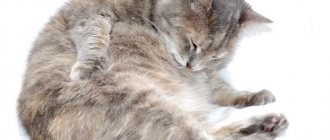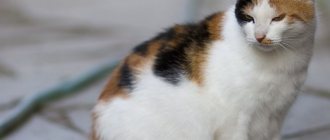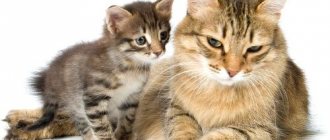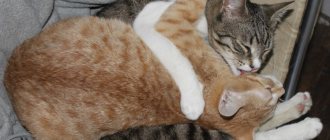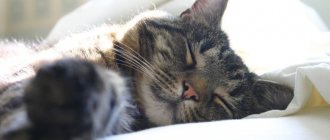How to determine pregnancy
Visually, a cat’s pregnancy can be suspected with an increase in the abdomen and appetite. It is imperative to see a doctor, because there are a number of pathologies that can also manifest themselves. And for further diagnosis, an ultrasound of the abdominal cavity will be required (1). Pregnancy can also be seen on x-rays.
1st – 3rd week of pregnancy in a cat
In the early stages it is very difficult to determine. Only at the beginning of the 3rd week is it possible to see something on an ultrasound, but the cat itself does not show any external signs of pregnancy. Therefore, you will be surprised by the middle of the term, when the cat begins to show obvious signs of motherhood.
4 – 6 weeks of pregnancy in a cat
Only at the beginning of this period does the cat’s nipples begin to change color and they swell.
Also, some cat mothers experience attacks of morning sickness during this period (just like in humans!).
Even during this period of pregnancy, the cat begins to gain weight, she becomes more affectionate and playful, and begins to demand more attention from her owners.
At week 5, the cat’s tummy enlarges and becomes denser.
7 – 9 weeks of pregnancy in a cat
At week 7, you can feel the kittens moving if you lightly put your hand on their tummy.
Don’t be afraid to touch and stroke a pregnant cat, because during such a period the cat really needs care and affection, and a person you can trust. And, of course, when kittens are already obvious in the stomach, your cat certainly cannot hide the pregnancy from you.
If you have a purebred cat and you really need to know about the onset of her pregnancy, the sooner the better, then already 2 weeks after the expected pregnancy occurs, you can take your cat for an ultrasound and the ultrasound will show whether there is a pregnancy.
What happens at different times
The duration of pregnancy in a cat ranges from 59 to 73 days. This period can be divided into 6 stages:
- From the moment of conception to 18-20 days. The animal's behavior remains virtually unchanged. You may notice only a slight increase in appetite. About 24 hours after mating, ovulation occurs, the egg is fertilized and moves to the uterus, where the embryo attaches to the wall.
- 20-30 days. There is noticeable swelling and redness of the mammary glands, tension and a slight increase in the abdomen. Sometimes there are signs of toxicosis - the pet appears periodically vomiting.
- 5th week. The abdomen is noticeably enlarged. The pet sleeps and eats a lot. At this time, the veterinarian can determine pregnancy by palpating the abdominal cavity and even recognize the number of embryos. You should not touch the cat’s belly yourself, as this can harm future cubs. In addition, careless palpation can lead to miscarriage.
- 6th week. Not only does the cat's belly increase, but its sides also swell.
- 42-50 days. Restless behavior appears, the animal may refuse to eat. Future kittens grow up to 5-8 cm, they have fur. The cat sleeps a lot and often visits the litter box, as the uterus with embryos puts pressure on the bladder.
- From 50 days until birth. The kittens are actively moving, their movements can be seen if you look closely at the pet’s belly. Towards the end of pregnancy, the cat's stomach drops and mucous discharge leaves the genital tract. She begins to look for a suitable place for the cubs to be born. The birth of kittens occurs on days 50-72.
How to determine the gestational age of a cat? Only a veterinarian can determine this with certainty. The owner of the animal can only count the number of weeks after mating and, based on the above criteria, determine the approximate period.
Caring for a pregnant cat
Pregnancy in a cat requires increased attention and proper care. Here are a few things to consider.
How to feed a cat during pregnancy
During pregnancy, cats should be given special food for pregnant and lactating cats. It contains all the necessary vitamins and microelements designed for bearing offspring.
– Already in the first weeks of pregnancy, the cat becomes less active, and its appetite increases. It is better not to limit the cat’s food intake at this time, just make sure that she does not gain excess weight. Play with her so that she moves more, recommends felinologist Elena Vishneva.
When feeding an animal with industrial feed, you can add nothing additional to the diet.
You should not change your diet suddenly, you just need to change to food from the same company that you fed, but special food for pregnant women or kittens, they are more enriched in composition than the usual everyday diet.
A natural diet in itself is wonderful, but any owner must approach the choice of such nutrition very seriously: how and how much and what to give to your pet, the required amount for its weight, for this it is necessary to calculate all the norms.
Therefore, during pregnancy, if all the norms of your natural nutrition are fully met, then, as a rule, it is enough just to increase the volume of the diet and increase the frequency of meals up to 4 times a day.
It is useful to add calcium to your diet, for example in the form of cottage cheese. Vitamin supplements should be administered with caution based on your cat's diet (complex vitamins from a pet store). For example, with an excess of vitamin A, mutations can occur in offspring. Additionally, the introduction of calcium in the form of drugs, if abruptly discontinued in a nursing cat, can lead to eclampsia (lack of calcium leading to convulsive phenomena). Hypercalcemia is fraught with a number of pathologies.
Is it possible to give medications to a pregnant cat?
There are a small number of medications and drugs that can be used during pregnancy, and only the doctor, and not the owner himself, should decide what medicine your pet needs.
And, despite the fact that the manufacturer’s instructions indicate whether the drug can be used or not during pregnancy or not, only a doctor can decide whether to give medication to your pet.
How to prepare for a cat giving birth
A week before giving birth, the cat begins to produce colostrum. It is noticeable by the dried droplets around the nipples. The animal's activity decreases, the cat sleeps more. By this time, we need to prepare a cozy nest for her, where she can hide and begin to prepare for childbirth.
“A day or two before giving birth, you need to spend more time with a pregnant cat: petting them, massaging their tummy,” advises Elena Vishneva.
Fighting skin parasites
It is better to eliminate ticks, fleas and other parasites that live in the coat and on the skin before mating. These insects are carriers of infections that can cause miscarriage during pregnancy. It is quite difficult to carry out preventive measures during pregnancy. Most drugs against parasites are toxic; their active components can cross the placenta. As a result, babies may die in utero or be born with developmental defects.
It is believed that during pregnancy, wool can only be treated with Stronghold. This is the most gentle remedy. However, it is still better to consult a veterinarian about this.
What to do when giving birth to a cat
The first signs of the approaching birth are already visible when the kitty begins to fuss in her nest, her breathing quickens, she often licks herself, she begins to tremble and her pulse quickens. The cat senses our nervousness, so we need to calm it down with a gentle voice, pet it, and massage its tummy. Remove bright light.
– If labor pains continue for more than 24 hours, it is better to seek help from a veterinarian. You may need a caesarean section, says Elena Vishneva .
Before giving birth, a cat may change its behavior, “build a nest”, its nipples will swell, and before giving birth its body temperature may drop to 37 °C.
When a cat begins to give birth, the main thing is to provide her with comfortable, calm conditions, silence and not to disturb her. Most animals give birth on their own without any complications. In case something doesn't go according to plan, you need to have contacts for a veterinarian who can come to your home to help with the birth.
From medications you can stock up on calcium gluconate and Oxytocin. Childbirth can last up to 24 hours. The time between births of kittens can take up to several hours. During labor, you can stroke your cat's belly if it doesn't cause her discomfort.
If the kitten is stuck or does not come out head first, you need to help him get out - you need to gently pull the baby, not holding the paws, but the body or the skin on the withers. It is better if you do this with sterile hands or sterile gloves.
If the cat itself has not ruptured the amniotic sac, it is necessary to help her with this by carefully cutting it without harming the kitten.
The cat should initiate the kitten's breathing process by licking it. If she doesn't do this, you should encourage the kitten to breathe by stroking her back and rubbing her. You may even need to shake him upside down if he is breathing strangely (he may have inhaled amniotic fluid).
– It is also important to carefully monitor how many kittens and placenta are produced. And after the birth, with the help of a veterinarian, make sure that there is nothing left inside,” says veterinarian Marina Mikheenko.
How many kittens can a cat give birth to?
Cats reach sexual maturity at approximately 8-9 months. And before the age of 1 year, she is already able to become pregnant and bear offspring. However, experienced breeders understand that this is quite early, and consider such births to be risk factors, since the body is still too young.
Note to the owner! It is not recommended to breed domestic cats under 1 year of age, although in the case of backyard dwellers we cannot in any way influence this fact. It is advisable to wait until the cat is one and a half years old, when the cat’s body is stronger and ready to bear healthy offspring.
Primiparous cats usually give birth to a small litter: 1-3 babies. This is explained by the reproductive system not yet fully formed. Overmature felines also give birth to few kittens, since their reproductive function is already fading. Cats, healthy, well-groomed, in their prime, usually give birth to up to 6 kittens.
Nature has endowed a cat with only 8 nipples. This means that she can feed no more than 8 cubs at a time. But sometimes there are exceptions: cases have been recorded when a cat gave birth to more than 10 or even 12 kittens.
The maximum number that a domestic cat can give birth is difficult to determine. Some breeders believe that this depends on the number of nipples the cat has. If you count them and subtract the number 2 from the sum, the resulting number will indicate the maximum number of kittens that a cat can have. However, this method of determination cannot be called absolutely reliable, although it can be adopted for yourself.
Physiologically, the number of offspring is determined by the number of attachment sites of fertilized eggs to the walls of the uterus, which in cats consists of 2 horns. This is why young and older females give birth to fewer kittens than cats at optimal reproductive age.
It has been proven that street stray cats produce more offspring than domestic cats. Experts explain this fact by relaxation of the genetic apparatus in cats living in comfortable conditions. Representatives of the streets and courtyards are forced to leave behind numerous offspring in order to preserve the cat family.
False pregnancy in cats
False pregnancy is a pathological condition of an animal in which it believes itself to be pregnant, but is not. In this case, all the signs of pregnancy may appear: nipples swell, colostrum is released, behavior changes, the cat may begin to build a nest.
This happens under the influence of the production of sex hormones. In advanced cases, an increased amount of colostrum can affect, for example, the formation of mastitis.
Any such condition is stressful for the animal and can ultimately lead to many pathologies. And if before this you did not want to sterilize your cat, the manifestations of a false pregnancy should make you think and take your cat for sterilization. After all, in the future you can get diseases such as pyometra, ovarianitis, endometritis and breast cancer with the highest percentage.
Early neutering can prevent all of these pathologies if the cat never gives birth. Remember that every time a cat goes into heat, it experiences severe stress, which, in addition to wasting hormone production, triggers other pathological processes.
In case of false pregnancy, it is important to consult a veterinarian for advice - he will tell you what medications should be given to reduce the production of colostrum, and prescribe additional treatment, if necessary. On your part, you need to limit your cat's stress and reduce fluid intake.
“It would be good to try to distract the cat from her thoughts about pregnancy, for example, to play with her more often,” advises veterinarian Marina Mikheenko .
By the way, there is an opinion among people that a cat should be allowed to become pregnant and give birth once, so that it can bear offspring and be immediately sterilized. In fact, mating a cat before sterilization is not contraindicated - this can affect both the health and psyche of the animal. The most favorable age for sterilizing a cat is after puberty, which occurs at 10 months (2).
If the birth of kittens is undesirable
If the conception and birth of kittens is undesirable, then it is better to sterilize the cat before the first mating. All methods of terminating pregnancy cause harm to the pet's body.
A pregnant cat tolerates sterilization much more difficult. Her hormonal levels are sharply disrupted, and the animal has to recover for a long time after the intervention. In a non-pregnant cat, the operation is much easier, and its condition quickly returns to normal.
There are other ways to terminate a pregnancy. In the early stages, the veterinarian may administer prostaglandins to the animal. These drugs cause miscarriage. However, after this the cat has to have its ovaries removed. This carries the risk of a uterine infection. Therefore, it may subsequently be necessary to remove the uterus. In fact, this method involves sterilization.
In the later stages, the veterinarian administers glucocorticoid hormones. As a result, the cat gives birth to prematurely unviable kittens. This is quite dangerous and can result in an emergency caesarean section.
Estrogens are sometimes used as a contraceptive for cats. Hormones are administered immediately after mating, this protects against pregnancy. But this method is far from safe. You have to use a fairly large dosage of the medicine. This often leads to serious endocrine disorders, persistent infertility, genital infections and hematopoietic disorders.
If the cat is not sterilized, then depriving her of access to males is also wrong. At the same time, the animal becomes nervous and irritable, as it experiences stress every time during the estrus period. Therefore, if the owner does not want the cat to reproduce, then the only correct solution would be sterilization before the first mating. This procedure is absolutely safe and harmless; it can be performed on an animal from the age of 8-12 months.
Popular questions and answers
We asked important questions about cat pregnancy to the felinologist, owner of the cattery, Elena Vishneva, and veterinarian Marina Mikheenko.
How long before pregnancy should a cat be vaccinated?
If the cat is not vaccinated, then vaccination must be carried out at least 1 month before the intended mating. And before vaccination, treat the cat with anti-helminth medications at least 10 days in advance.
Can pregnant cats be vaccinated?
Pregnant animals cannot be vaccinated; this can lead, for example, to abortion or a number of pathologies in the offspring. But, if there is a threat to the life of a cat, for example in a shelter, where there is a high risk of infection with, say, panleukopenia (which can be fatal), the veterinarian may decide to vaccinate.
Is it possible to pick up a pregnant cat?
You can and should pick up a cat in your arms to caress and stroke it. But any movements must be careful so as not to harm the fruit. Try not to pick it up by the belly, crush it, throw it, or cause discomfort to the animal.
What absolutely should not be done with a pregnant cat?
It is strictly forbidden to give the animal prohibited food, change the diet suddenly, do not give yourself any medications or medications prohibited during pregnancy, and limit stress.
Cats like everything to be as usual every day. Even the arrival of guests can cause stress in a cat. Sources
- Filippova O.V., Sorokin V.I. Ultrasound visualization of the genital organs as a method for assessing the state of pregnancy in cats and bitches // News of the Orenburg State Agrarian University, 2008 https://cyberleninka.ru/article/n/ultrazvukovaya-vizualizatsiya-polovyh-organov-kak-metod-otsenki-sostoyaniya- beremennosti-u-koshek-i-suk
- Soboleva A.A., Khokhlova S.N., Simanova N.G. Sterilization of cats // Innovative science, 2016 https://cyberleninka.ru/article/n/sterilizatsiya-koshek
Deworming
During pregnancy, a cat cannot be dewormed. All anthelmintic drugs are toxic and can harm the embryos. It is necessary to take care of getting rid of internal parasites 7 days before mating.
If this procedure was not carried out in advance, then deworming is done 1 month after birth. The cubs also undergo anthelmintic treatment together with the mother. The cat is given an anthelmintic drug that can be used during lactation, and kittens are given a special suspension.
Age at which a cat can become pregnant
Many people wonder at what age a cat can become pregnant for the first time. Puberty can begin between 4 and 12 months of age during the first heat cycle. In individuals of different breeds and body types, the first heat does not appear at the same time. In the case of long-haired and large cats, it occurs when their age reaches 10-12 months. These cats include Norwegian, Siberian and Maine Coon. Small cats with short hair have an earlier development. They become sexually mature at the age of 4-5 months. Representatives of shorthairs are “British”, Siamese and Burmese cats.
Estrus is the name given to discharge from an animal's genitals. The following signs may indicate that heat is approaching:
- the pet's desire to receive more affection;
- friction against the owner's legs;
- rolling on the floor;
- tail wagging.
Important! Outdoor cats go into estrus 2 times a year in spring and autumn, and domestic cats - every month. The pet's body weight increases by 2-2.5 kg. Females are characterized by various external changes
However, people who got a cat for breeding should know that the onset of puberty does not mean that the female can already mate to produce offspring. The body of a cat less than 10 months old will not be able to bear and give birth to kittens for physiological reasons.
The pet's body weight increases by 2-2.5 kg. Females are characterized by various external changes. However, people who got a cat for breeding should know that the onset of puberty does not mean that the female can already mate to produce offspring. The body of a cat less than 10 months old will not be able to bear and give birth to kittens for physiological reasons.
After the onset of heat, the following behavioral and physiological changes are also noticeable in females:
- long and loud meowing. A cat may make loud noises all day long;
- frequent licking. This way the cat removes clear secretions;
- enlargement of the genitals. This will be indicated by a change in gait and frequent trips to the litter box;
- adopting a mating position. The female's readiness to continue the race is indicated by the lowering of the front part of the body and raising of the back. At the same time, she moves her tail to the side;
- marking the territory. This is a method of attracting cats that are sensitive to pheromones that are released from urine;
- excessive affection or aggressiveness. The animal tries to gain more attention from the owner, wants to be petted, or begins to react aggressively to the owner’s affection;
- desire to go for a walk. During the sexual hunt, the cat every time tries to get out into the street through a door or window.
A meowing cat can irritate its owner
The period of active sexual hunting usually takes no more than 5-7 days.
When do you need veterinary help?
In most cases, the cat copes with the birth of kittens on her own. But there are times when the help of a loving owner is extremely necessary. Sometimes, due to fatigue and pain, a cat can “squeeze” a cub that is only halfway out. Most often, this happens if the kitten walks forward with its hind legs.
Such situations require immediate intervention. The easiest way to help is to grab the cat by the scruff of the neck so that it stands upright on its hind legs.
By switching to a new stimulus, the woman in labor will relax the vaginal muscles and the kitten will be born. If this does not help, then more radical measures should be taken. You need to carefully take the kitten with a gauze cloth (a clean cloth or a gynecological glove) and pull it out with light, rocking movements. This should be done at those moments when the cat begins to struggle.
Normal birth in British cats does not require specialist intervention. However, owners should observe how the cat behaves after giving birth. If certain symptoms occur, you should immediately call your nearest veterinary clinic.
We suggest you read: Fleas on a cat - how to identify and get rid of them
• labor does not begin more than 70 days after conception;
• there are signs of fever and increased temperature in cats before giving birth;
• fever in cats after birth;
• the appearance of bright red discharge from the vagina, lasting more than 10 minutes;
• unpleasant and pungent odor from the vagina;
• contractions in cats without continuation of labor for a long time (more than an hour);
• restless behavior of the cat after the termination of labor.


